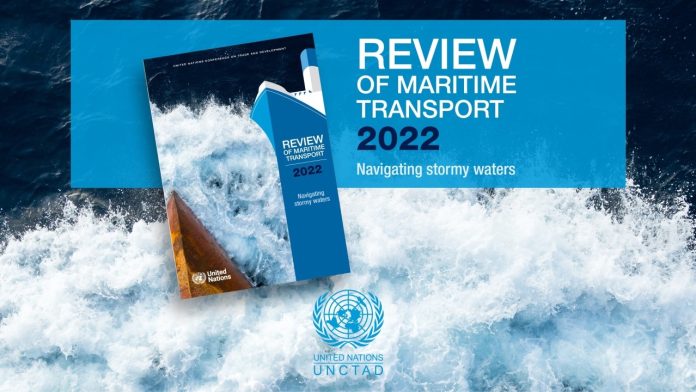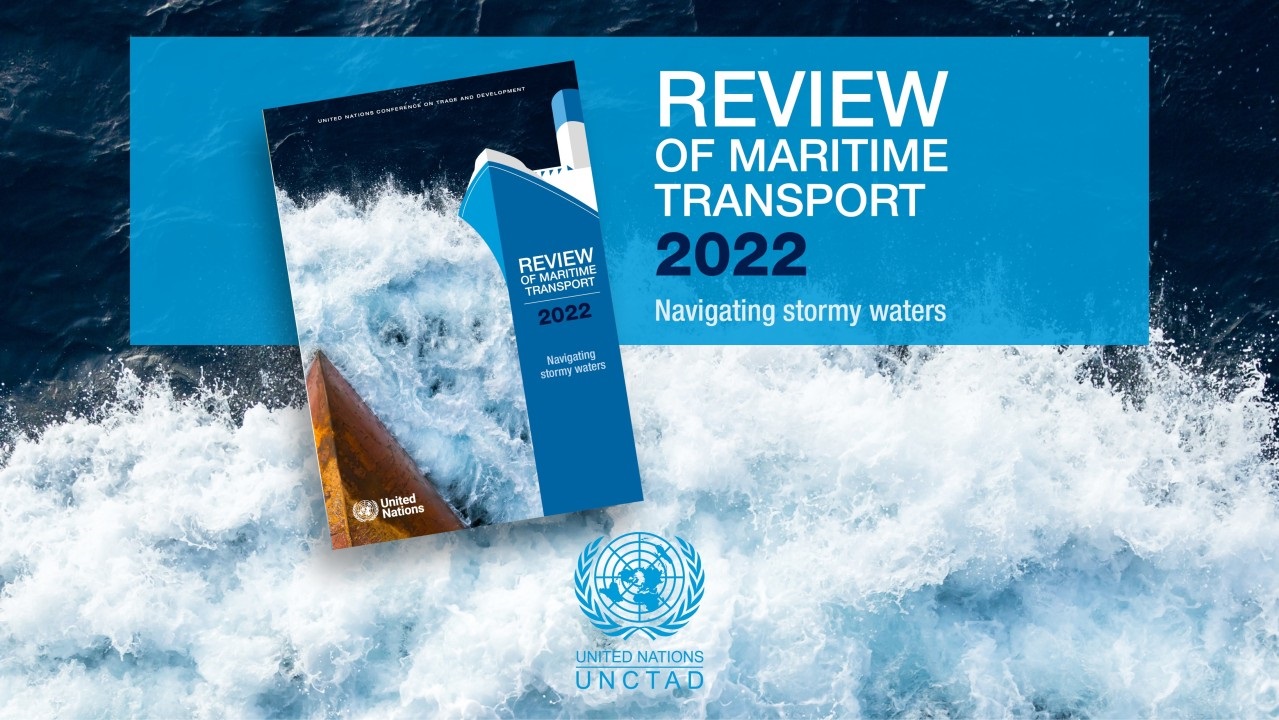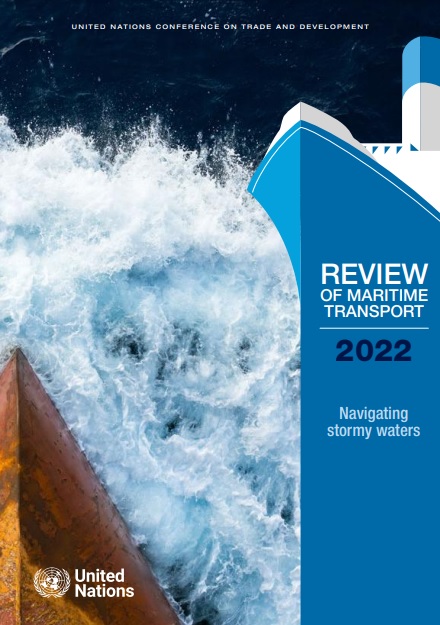
(www.MaritimeCyprus.com) The Review of Maritime Transport is a recurrent publication prepared by the UNCTAD secretariat since 1968 with the aim of fostering the transparency of maritime markets and analysing relevant developments. This edition of the Review covers data and events from January 2021 until June 2022.
Rarely has the importance of maritime logistics for trade and development been more evident than during the last year. Historically high and volatile freight rates, congestion, closed ports and new demands for shipping following COVID-19 and the war in Ukraine have all had measurable impacts on people’s lives. With ships carrying over 80% of volume of global trade, higher shipping costs and lower maritime connectivity lead to higher inflation, shortages of food, and interruptions of supply chains – all of which are among the features of the current global crisis.
Highlights commentary by Jan Hoffmann, Head, Trade Logistics at UNCTAD:
1. Are emissions from shipping going down? Yes and no
Emissions from shipping have kept going up: plus 4.7% in 2021. But over the last decade, if compared to the volume shipped, they have gone down per ton-mile, which is at least some good news. But there is another “but”: Building on data from Marine Benchmark, we show that about half of the improvement in the emission intensity is due to economies of scale and some slow steaming. Not a real technological improvement. And certainly not due to the use of alternative fuels.

2. While the fleet is getting older
In response to an initiative of our partners at the International Chamber of Shipping, and building on data from Clarksons, we have added a new table to our on-line maritime statistics with the average age of the fleet by nationality (flag) and vessel type. You can download the complete table in xls, or flip through the different measures (dwt, units, GT, market share, and age) on-line. The table will in future years be incorporated into the ICS Flag State Performance Table.


Looking at different vessel types, no big surprise to see that general cargo ships are the oldest of the main categories.
Why has the age been creeping up? Reasons are manyfold and have to do with long-term shipping cycles and trends in demand for different ship types and sizes. One of the reasons is – we believe – that at least some owners are reluctant to invest in new ships if the future requirements as regards fuels, carbon prices, and regional and multilateral regulations are more uncertain than ever. Thus, there is a linkage between low fleet renewal, the decarbonization of shipping, and potential future shortages of supply – in the long-term.
3. Shooting a flying bird
Container spot freight rates have been in free-fall in recent months. It is not the purpose of an annual analytical report that is researched, peer reviewed and edited over many months, to cover the daily ups and downs. Or rather downs and downs if we look at container rates over the last weeks.
But we can analyse underlying causes, and we can provide long term trends and comparisons across regions and routes. We have done this, inter alia, in collaboration with Transporeon and a novel dataset on inter-regional contract freight rates.

And it all makes sense: Intra-African freight rates are far higher than intra-Asian freight rates. During the pandemic, rates out of Asia have surged, while some rates out of Africa and North America have gone down. Trade imbalances matter: Asia-Africa contract rates are 4 times higher than in the opposite direction.
4. And what do higher freight rates mean for prices?
Last year, we can proudly say that we predicted the impact of higher freight rates on inflation. Team had simulated an impact on consumer prices of an extra 1.5 percentage points. And this was later confirmed by the IMF when the real data came in.
This year, there was a look at the impact of higher bulk shipping costs on food prices. Although dry bulk freight rates have recently declined again – partly thanks to the Black Sea Grain Initiative – it is still interesting to see which countries are more negatively affected, and why.

Consumer food prices went up in early 2022, and about half of the increase is due to higher dry bulk freight rates. However, the impact is not evenly spread. Interestingly the Least Developed Countries are less strongly impacted by shipping costs for bulk grain. The reason is that they do not import that much raw wheat or corn, but rather depend on processed food imports.
5. Shifts in fleet deployment and port calls during the pandemic
As ships spent more time in port and there was no spare capacity left, capacity utilization went up. The number of container ship port calls went down, while the proportion of container ships that were fully laden increased from 51% pre-covid to 60% in 2021 and 2022. Benefitting from data from our partners at MarineTraffic, Sea/, and MDS Transmodal, we can compare, analyze, and share these shifts in vessel deployment and port calls.

In most regions, between 2019 and 2021, actual port calls for container ships declined both, in absolute numbers and also when compared to scheduled port calls. The discrepancy was particularly high in Oceania and Sub-Saharan Africa, as capacity was re-deployed to more lucrative routes. But in North America, too, actual port calls went down, as ships were stuck waiting in congested ports.

6. Port performance for tankers and dry bulk
Qatar is the world champion. At least when it comes to the speed of loading tanker cargo onto VLCCs. At almost 260 tons per minute, it has the world's best port performance for liquid bulk.
For dry bulk, the fastest loading times are recorded for Brazil, at almost 78 tons of cargo per minute, followed by Australia at 71 tons per minute.
In the Review, we have several maps and tables for different cargoes and ship sizes. Below the case for Very Large Crude Carriers.


7. What to do?
During the pandemic, we have received growing demands and requests for support under our technical assistance programmes in trade facilitation, maritime transport, port management, legal advice, and Customs automation.
There are a number of trade facilitation measures can help especially when it comes to digitalizing procedures and reducing speed. Unfortunately, many of these solutions are lagging behind in their implementation rate as reported by the WTO Trade Facilitation Facility.

With much of global commodities trade conducted on CIF and FOB terms, the pandemic also has legal implications for many closely interconnected commercial contracts. In all cases where performance is disrupted, delayed, or has become impossible, legal consequences and claims arise, involving complex jurisdictional issues and increasing the need for costly dispute resolution. Building on a recent dedicated UNCTAD report, the RMT recommends that commercial risks arising from the pandemic should be fairly allocated through suitably drafted contractual clauses, but considerations will differ depending on the type of contract and the relative bargaining power of the parties. Governments can also provide support, for example by strengthening formal and informal dispute resolution mechanisms and by considering possible mandatory controls on container demurrage accruing at pandemic-affected ports.
8. A special chapter on consolidation in container shipping
The process of concentration in liner shipping is not new. In the Review, we provide the long-term trends and data, including on horizontal and vertical integration. Please read Chapter 6 for the complete assessment.

In our analysis we are careful not to mix the recent supply chain crisis with the long-term trends and causes of the process of concentration. During the COVID-19 pandemic, the charter rate increase (charged by the less concentrated shipowners to the more concentrated container ship carriers) was even greater than the freight rate increase (charged by the carriers to the shippers). Also, the price increases were even more pronounced in most other shipping markets, including dry bulk, gas, and oil tankers.
Still, we are concerned about the trends that lead to less choice for shippers, posing challenges for regulators, competition- and port authorities, especially in smaller economies with weaker institutions. Four sets of recommendations focus on
- transparency,
- capacity building,
- anti-trust immunity and alliances, as well as
- international coordination and cooperation.
9. Original data from our TRAINFORTRADE network
Benefitting from hard data from our partner ports in the UNCTAD port management network, we can analyse trends and KPIs from ports in sixty countries. When it comes to gender participation in different functions in the port, no big surprises. Female staff is more likely to be found in management positions than among the dock workers.

10. The future: one forecast and four scenarios
What will be the growth of seaborne trade over the next few years? Building on estimated elasticities of maritime trade with respect to GDP, export volumes, the investment share in GDP and monthly seaborne trade data published by Clarksons Research, combined with the GDP forecast published in the International Monetary Fund, World Economic Output, October 2022, here is our forecast.

The longer-term future for shipping is more uncertain than ever. Not only do we have the still ongoing crises of the pandemic and the war in Ukraine, but above all there is forthcoming energy transition and the need for decarbonizing shipping.
For the next years, here are four scenarios.

Beyond these medium-term scenarios, my personal main concern remains the danger that uncertainty about future developments leads to under-investment in the necessary energy generation and distribution, port and hinterland infrastructure, and shipping fleet renewal.
The immediate outlook is one of oversupply of container ships, as there has been a surge in new orders in 2021 and 2022, some of which will be delivered from 2023 onwards. However, with higher risk premiums and uncertainty as regards future technologies, regulations, carbon prices, and availability of alternative fuels, private sector investors will likely prefer to wait with new projects.
Click below to download the full UNCTAD 2022 report:
Source: United Nations Conference on Trade and Development (UNCTAD)















